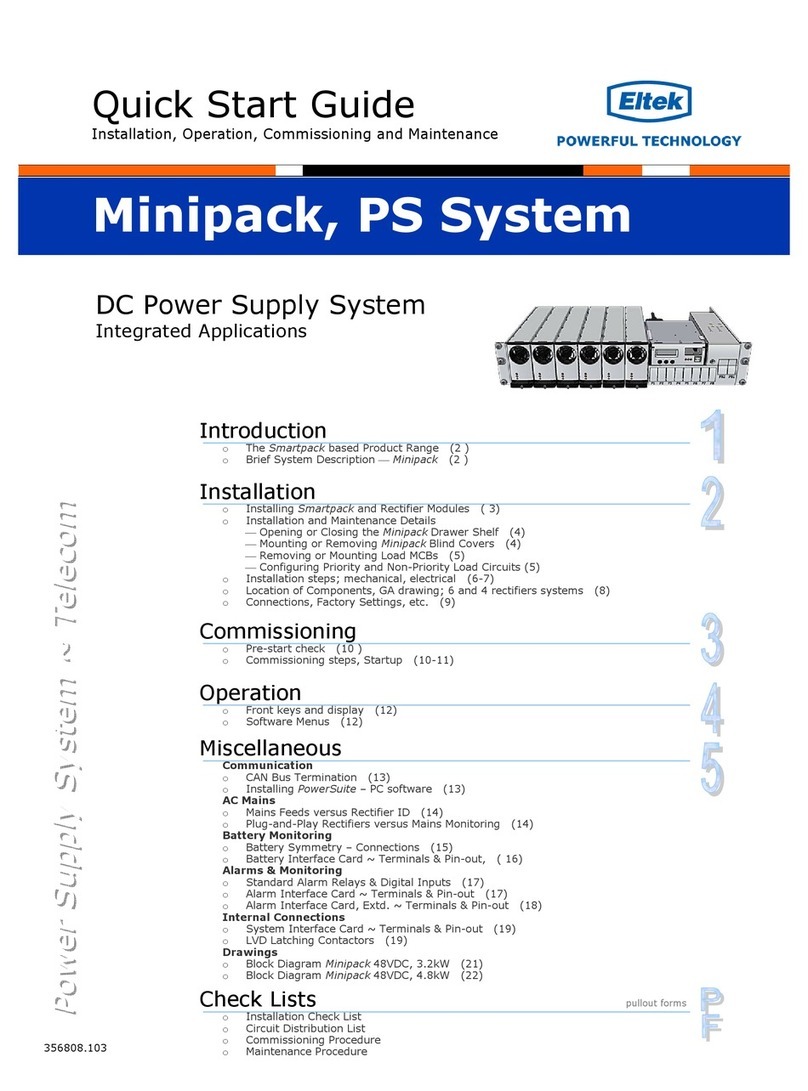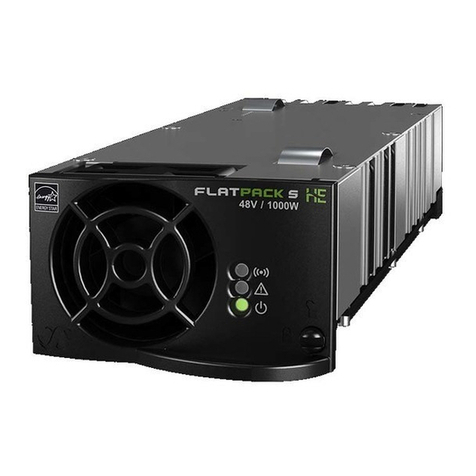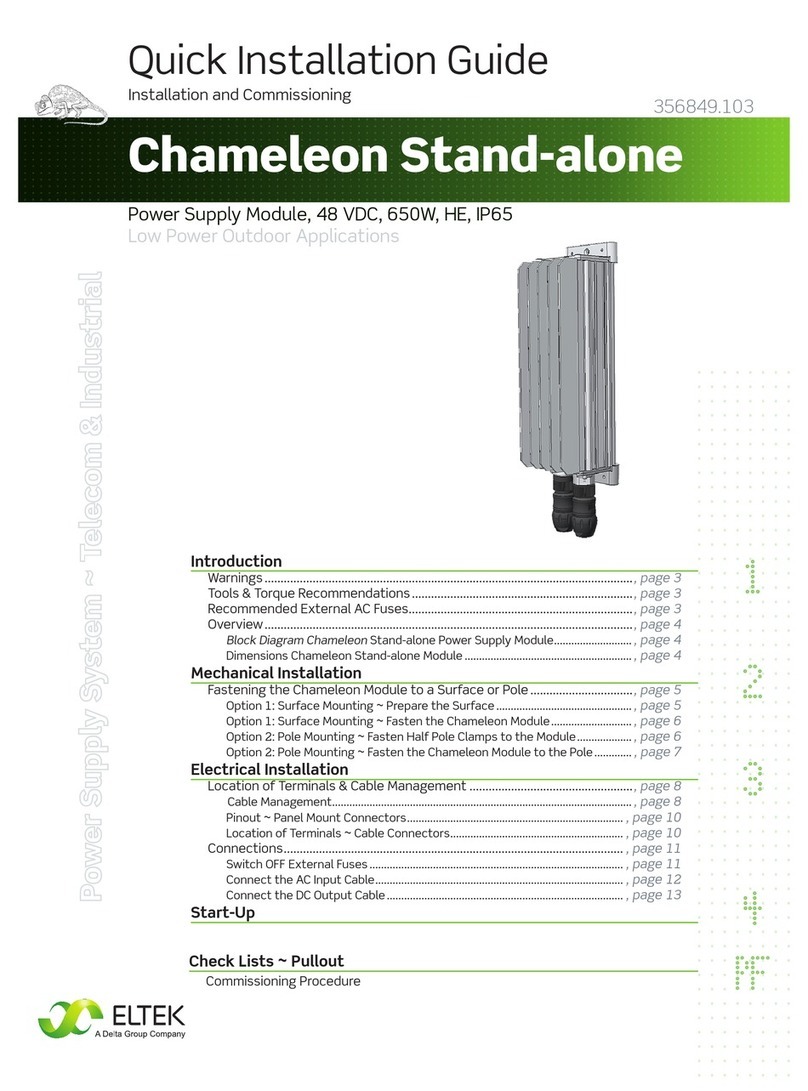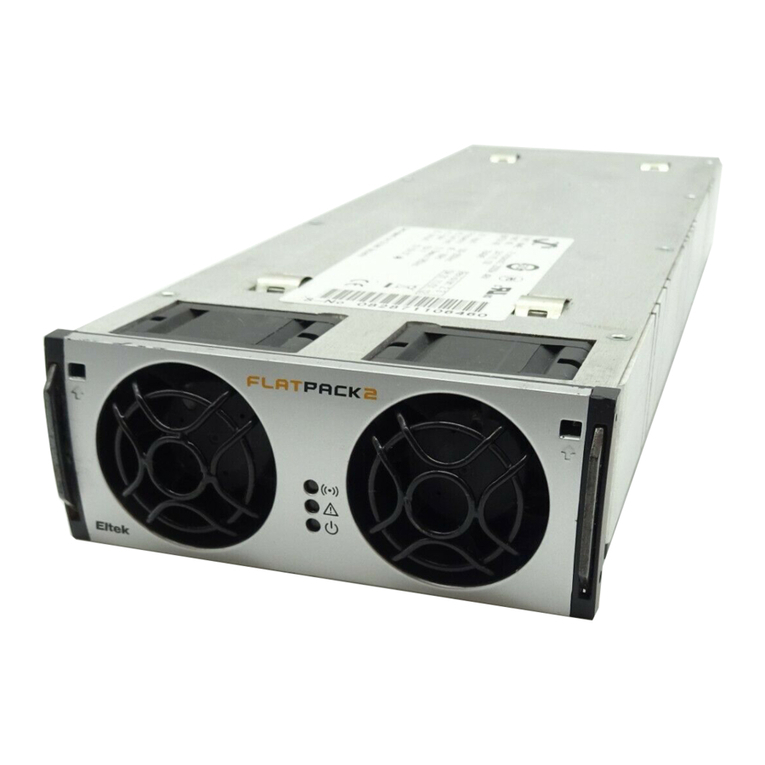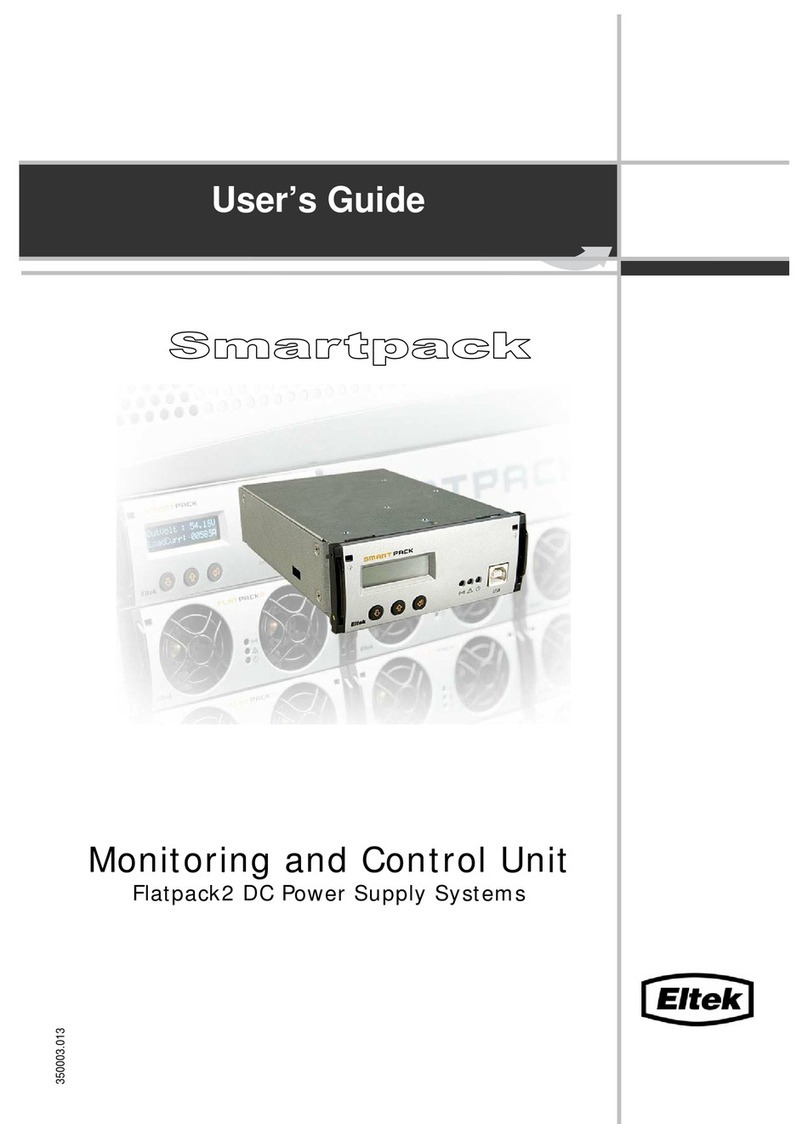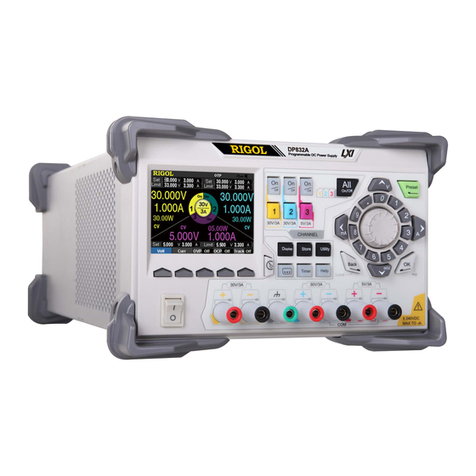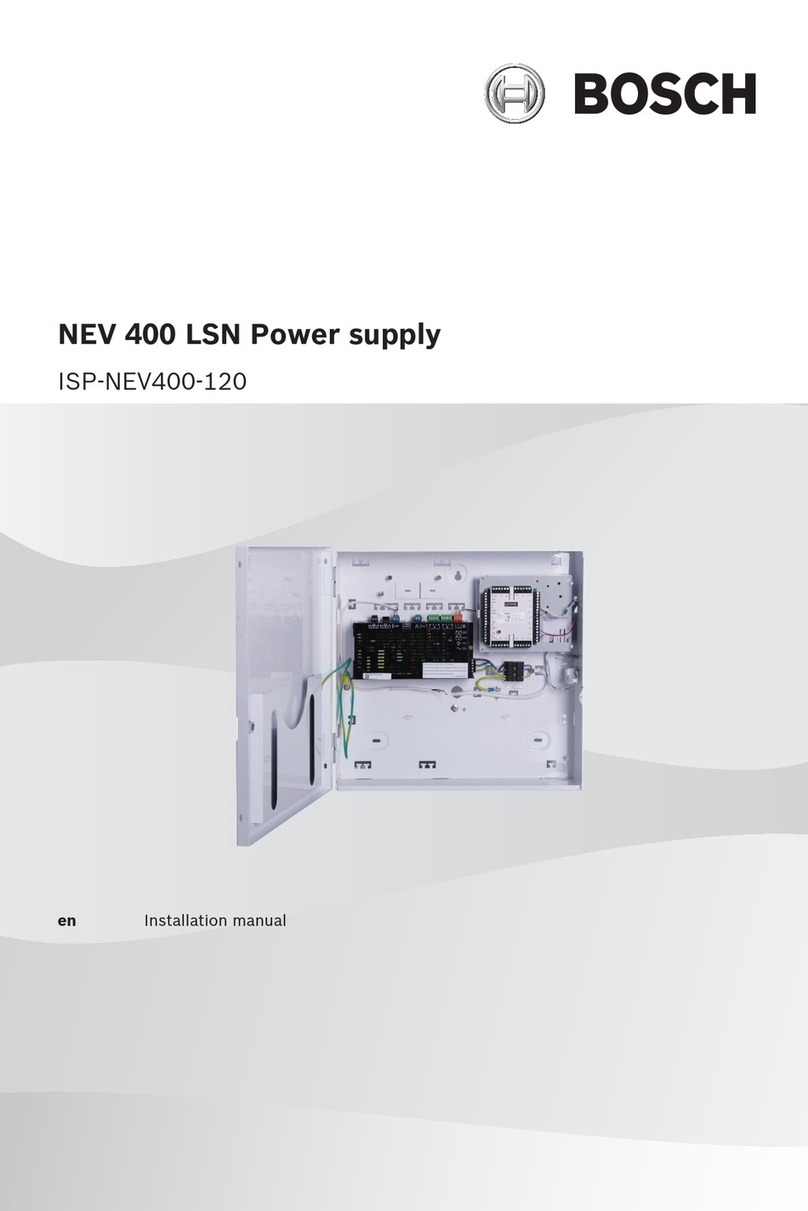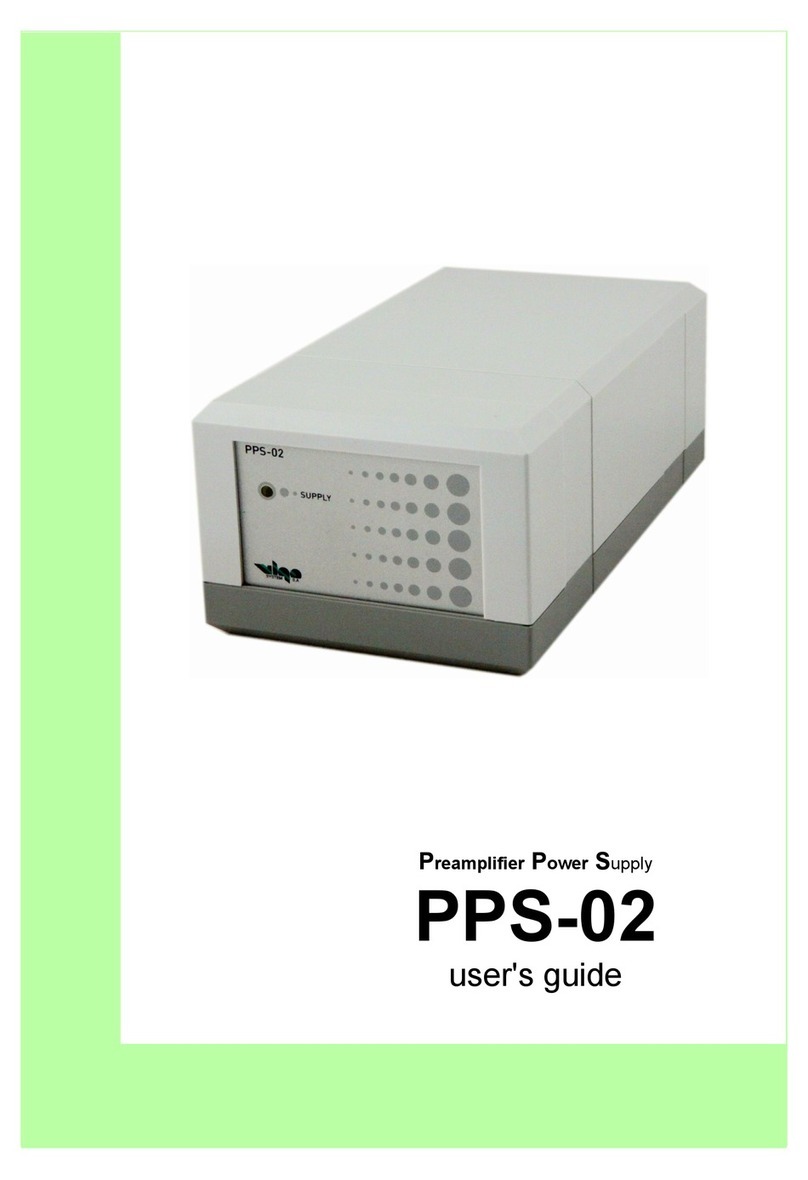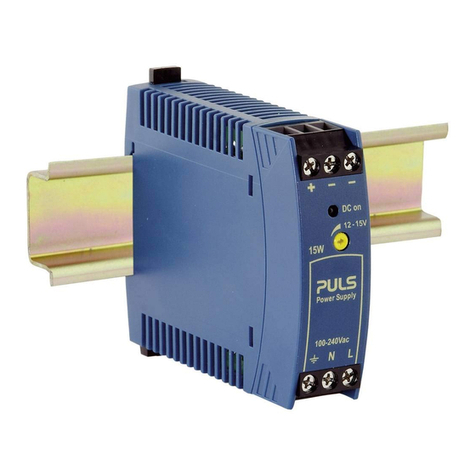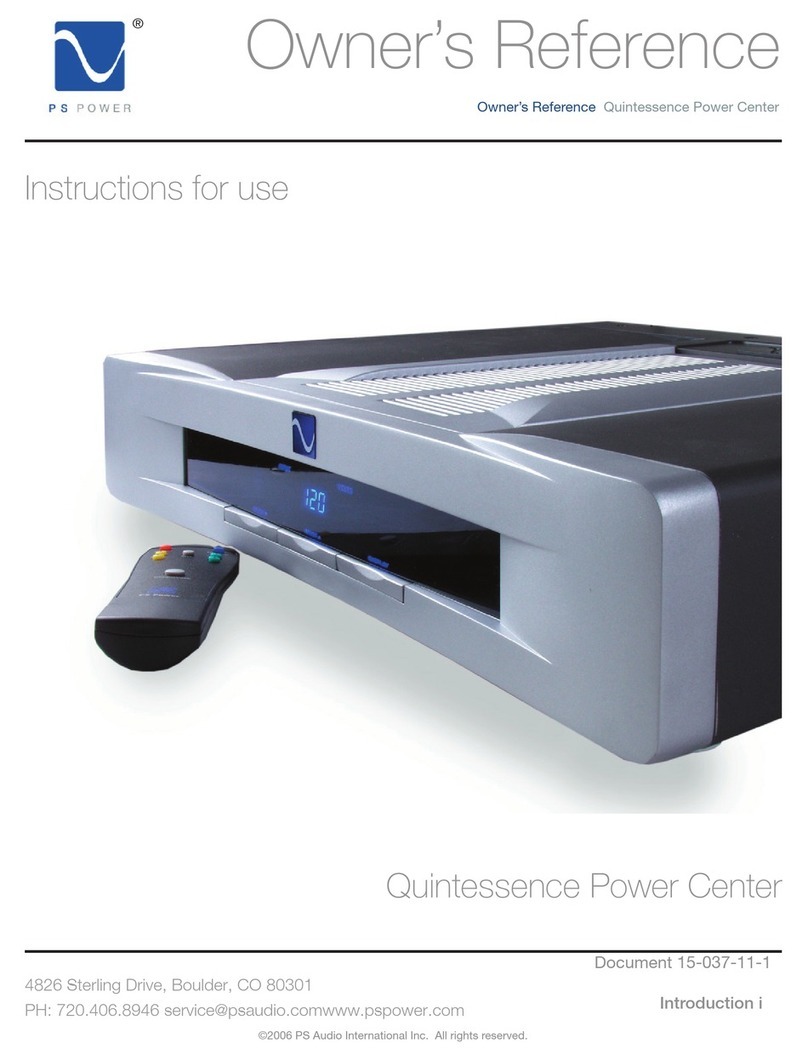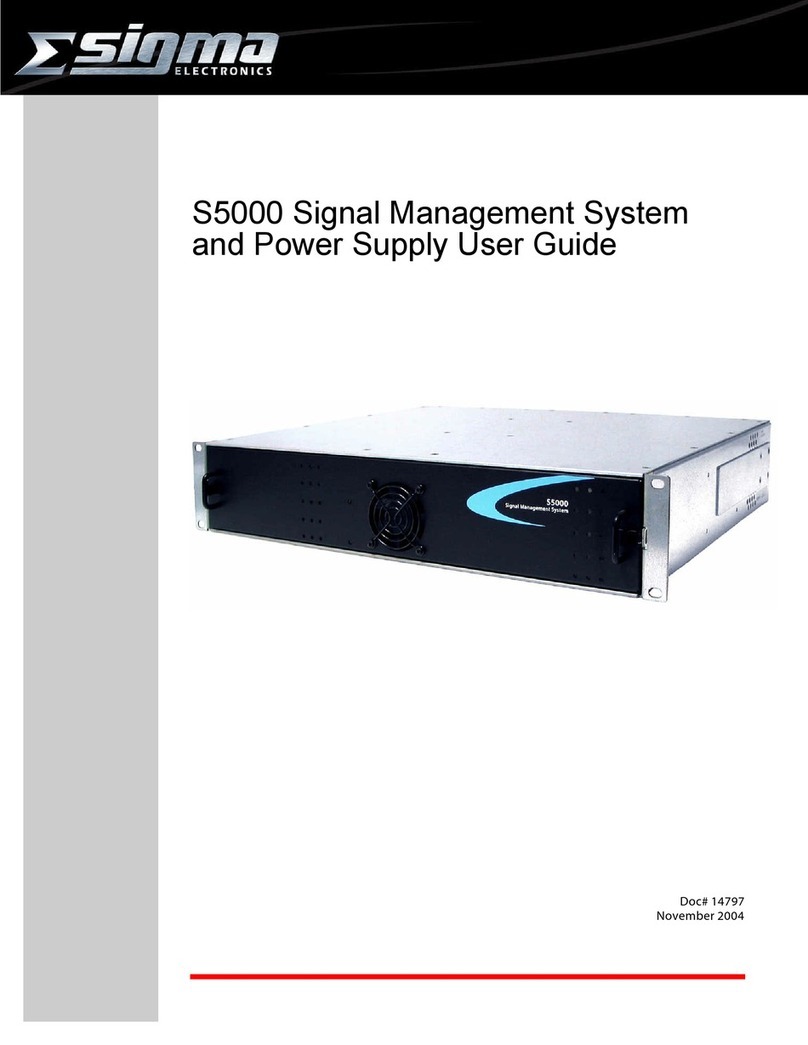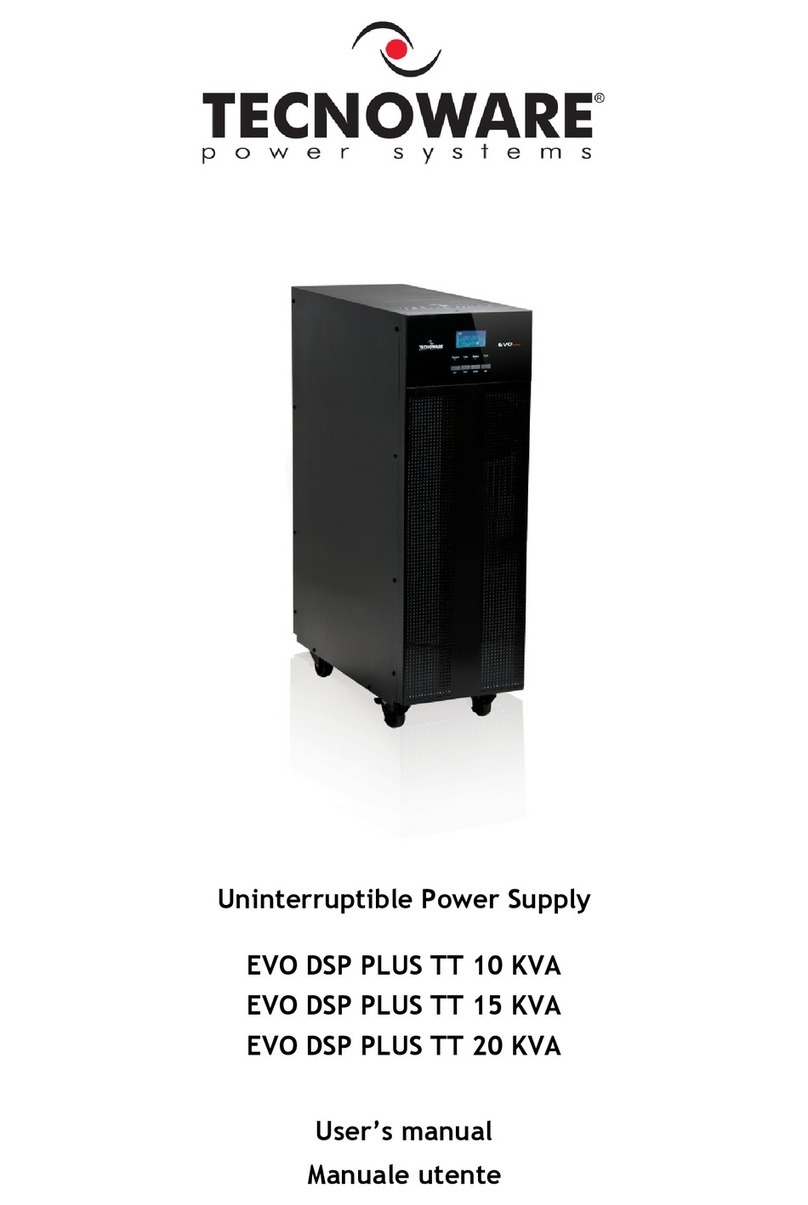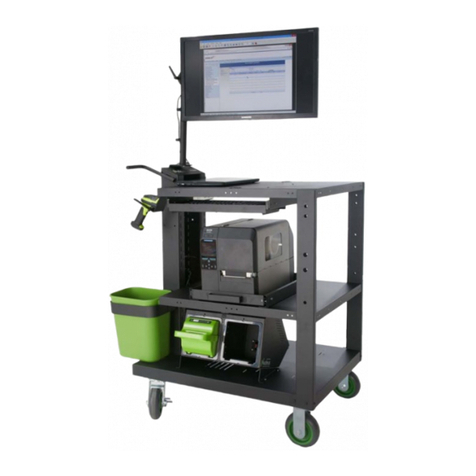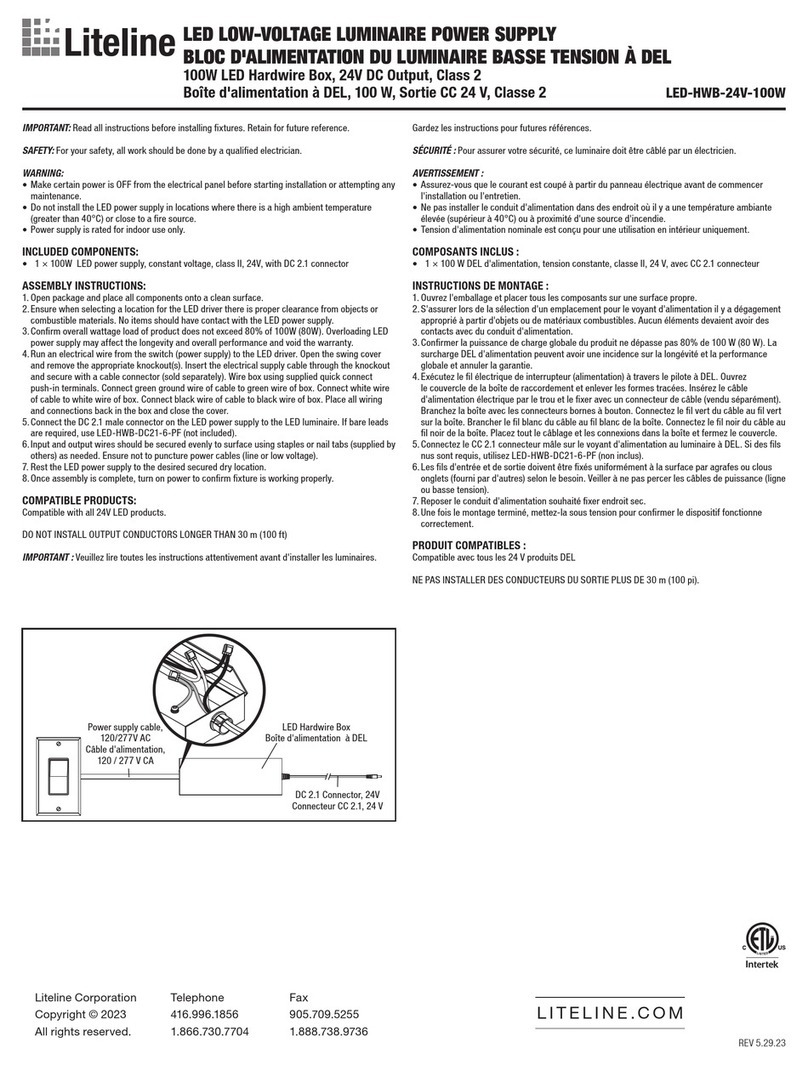Eltek Flatpack Power Tower User manual

351401.013
Issue 2
July 2003
Flatpack
Power Tower
Operation Guide

2(48) Operation Guide, Flatpack Power Tower
351401.013v2 July 2003
Information in this document is subject to change without notice and does not represent a commitment
on the part of ELTEK Energy.
No part of this document may be reproduced or transmitted in any form or by any means — electronic
or mechanical, including photocopying and recording — for any purpose without the explicit written
permission of ELTEK Energy.
Copyright ©: ELTEK Energy, Norway 2006
NS-EN ISO 9001:1994 Certificate no: 900005Q NS-EN ISO 14001:1996 Certificate no: 900005E.
This product holds a CE mark and satisfies all requirements covering relevant standards and directives.
EMC
Generic Immunity Standard
▫EN61000-6-1 Residential, Commercial and Light Industry
▫EN61000-6-2 Industrial Environment
Generic Emission Standard
▫EN61000-6-3 Residential, Commercial and Light Industry
▫EN61000-6-4 Industrial Environment
ETS 300386 v1.3.1 Telecommunication Equipment
LVD
▫EN 60950 Safety of Technology Equipment
Certificate no: 900005E
Head Office:
Eltek Energy
P.O. Box 2340 Strømsø
N-3003 DRAMMEN
Norway
Certificate no: 900005Q
Phone: (+47) 32 20 32 00
Fax: (+47) 32 20 32 10
E-Mail: eltek@eltekenergy.com
Visit our Web site on Internet: http://www.eltekenergy.com
351470.013 Issue 2, July 2003
This document was produced using Microsoft Word

Table of Contents
Operation Guide, Flatpack Power Tower 3(48)
351401.013v2 July 2003
1 Table of Contents
1Table of Contents 3
2Key Stakeholders/ Document History 5
3Scope 7
4Description of Flatpack Power Tower 9
4.1 General ..............................................................................................................9
5Installation Procedures 11
5.1 Safety Precautions...........................................................................................11
5.2 Mechanical Installation ...................................................................................11
5.3 Earth connections ............................................................................................12
5.4 Mains Connections..........................................................................................13
5.5 General Arrangement ......................................................................................14
5.6 Installation of rectifiers ...................................................................................18
6System Monitoring 27
7Specification Flatpack Power Tower 29
8Figures 31

Table of Contents
4(48) Operation Guide, Flatpack Power Tower
351401.013v2 July 2003

2 Key Stakeholders/ Document History
Operation Guide, Flatpack Power Tower 5(48)
351401.013v2 July 2003
2 Key Stakeholders/ Document History
Name Title
Kjartan Albrigtsen Product Manager
Roar Linseth Technical Responsible
Written by Checked by Approved by
Rev Date Sign Date Sign Date Sign
V1 19.02.03 M.G.C. R.L.. K.A.
V2 18.07.03 M.G.C. 04.08.2003 J.K 04.08.2003 I.F
Rev.V1 First issue
Rev.V2 Updated to include Imperial measurements
The original signatures are recorded on the company’s logistic data system

2 Key Stakeholders/ Document History
6(48) Operation Guide, Flatpack Power Tower
351401.013v2 July 2003

3 Scope
Operation Guide, Flatpack Power Tower 7(48)
351401.013v2 July 2003
3 Scope
Flatpack Power Systems are made up of Power Shelves for plug-in rectifier modules, a DC distribution that
includes a monitoring and control unit and optional Batteries.
The power shelves include the necessary amount of rectifiers needed in the system. The DC distribution include
fuses, breakers (MCB`s), load and/or battery disconnect units as well as a Monitoring & Control Unit.
This Operation Guide contains information about the Flatpack Power Tower distribution. It includes information
about alarm connections, DC connections and optional equipment, together with a description on how to install
and commission the distribution.

3 Scope
8(48) Operation Guide, Flatpack Power Tower
351401.013v2 July 2003

4 Description of Flatpack Power Tower
Operation Guide, Flatpack Power Tower 9(48)
351401.013v2 July 2003
4 Description of Flatpack Power Tower
4.1 General
The Power Tower system is a power rack system based on the Flatpack 1500 W 48Vdc.
The systems contain a DC distr., until 6 Flatpack 1500 W 48Vdc. To provided monitoring and control Flatpack
Monitoring/Control Unit (MCU) are used. The distribution is rated for 200A, negative distribution.
The system is designed for cable entry from top. Prepared for 2 battery banks (2 x100Ah) and max. output
current of 200A.
DC output is made by connection between the positive rail and the different load/battery fuses. Negative
distribution is standard.
Cabinet size is 300x600x1800mm (11.8”x23.6”x70.9”).
The system is build up from a basic number and prepared for different armament (Valid option3).

4 Description of Flatpack Power Tower
10(48) Operation Guide, Flatpack Power Tower
351401.013v2 July 2003
4.1.1 Basic or extended functionality for monitoring and control
The Flatpack Power Tower is available with either basic- or extended functionality for monitoring and control of
the system. The type of interface PCB mounted inside determines whether the distribution unit has basic or
extended functionality. The pictures below show that the interface PCB used distribution units with basic
functionality has less wire connectors than the PCB used in distribution units with extended functionality.
A distribution with extended functionality includes five more alarm relay outputs (totally 11) in addition to the
standard monitoring and control features.
4.1.1.1 Basic functionality
4.1.1.2 Extended functionality
4.1.1.3 Front access interface PCB
Interface PCB for distribution units with basic
functionality (part no. 100350). Includes all
standard monitoring and control features.
See chapter 5.6.2.2Basic version (PCB part no.
100350) for more details.
Interface PCB for distribution units with extended
functionality (part no. 100145). Includes all
standard monitoring and control features and five
additional alarm relay outputs.
See chapter 5.6.2.3 Extended version (PCB part
no 100145)for more details.
Interface PCB for distribution units with basic
functionality (part no. 1001714). Includes all
standard monitoring and control features.
See chapter 5.6.2.4 Front Access PCB (PCB Part
number 101714) for more details.

5 Installation Procedures
Operation Guide, Flatpack Power Tower 11(48)
351401.013v2 July 2003
5 Installation Procedures
5.1 Safety Precautions
The equipment described in this manual must only be operated
by Eltek Energy personnel or by persons who have attended a
suitable Eltek Energy training course.
The equipment represents an energy hazard and failure to
observe this could cause terminal injury and invalidate our
warranty.
There are hazardous voltages inside the rectifier system. As
the rectifier units incorporate large charged capacitors, it is
dangerous to work inside the system even if the mains supply
is disconnected.
Products into which our components are incorporated have to
comply with a number of requirements. Installation is to be in
accordance with the recommendations herein.
Please read the manual carefully before using the equipment.
5.2 Mechanical Installation
Installation Step Comments Okay
1 TAKE THE FLATPACK POWER TOWER
OUT OF THE PACKAGING INSPECT THE DISTRIBHUTION UNIT FOR ANY PHYSICAL
DAMAGE.DAMAGED EQUIPMENT SHOULD BE RETURNED TO
YOUR SUPPLIER
Procedure 1: Mechanical Installation Flatpack Power Tower

5 Installation Procedures
12(48) Operation Guide, Flatpack Power Tower
351401.013v2 July 2003
5.3 Earth connections
The System Ground Cable must be connected to the Common Positive Busbar to ensure that the positive output
of the rectifiers will be connected to ground and the negative output will represent the – 48Vdc supply voltage.
The common positive busbar is connected to the chassis through an earth strap.
The ground point (M6 stud) is located
behind the AC terminals
Earth connection between
chassis and common
positive bar (system ground)

5 Installation Procedures
Operation Guide, Flatpack Power Tower 13(48)
351401.013v2 July 2003
5.4 Mains Connections
Installation Step Comments OK
1. VERIFY WHICH MAINS
CONFIGURATION IS APPLICABLE
FOR YOUR SYSTEM
Refer to label for Power Tower AC connections
2. IF NECESSARY,RECONFIGURE THE
MAINS TERMINALS ACCORDING TO
THE SUPPLY AVAILABLE
3. CONNECT THE PROTECTIVE
EARTH BEFORE ANY OF THE LIVE
TERMINATIONS
Procedure 2: Mains Connections Flatpack Power Shelf

5 Installation Procedures
14(48) Operation Guide, Flatpack Power Tower
351401.013v2 July 2003
5.5 General Arrangement

5 Installation Procedures
Operation Guide, Flatpack Power Tower 15(48)
351401.013v2 July 2003
5.5.1 DC Connections/Terminations
Cord
anchorage
Common
positive busbar
DC load MCB’s with the
negative output on top of
each MCB.

5 Installation Procedures
16(48) Operation Guide, Flatpack Power Tower
351401.013v2 July 2003
5.5.2 Description of battery connections
Connection of negative
pole from battery fuse
Connection of positive pole
(from common Positive Busbar)
Cutaway view showing
connection of a battery
bank in series

5 Installation Procedures
Operation Guide, Flatpack Power Tower 17(48)
351401.013v2 July 2003
5.5.3 Procedure for connection of DC cables
Installation Step Comments OK
1 DECIDE CABLE ENTRY The cables or copper bars can enter from top
2 DRESS THE CABLES INTO THE
CABINET,CUT TO LENGTH AND FIT
CABLE LUGS OR FERRULES IF
APPLICABLE
Use cable cutter and cable lug crimper fitted with
appropriate sized die.
For cables/wires
The holes are dimensioned for M8 bolts, which are fitted
at delivery
3 FASTEN THE CABLES TO THE DC
TERMINALS
See chapter “connections/terminal” for connection
details
6 FASTEN ALL CABLES AWAY FROM
SHARP EDGES AND RELIEVE ANY
STRAIN FROM THE TERMINALS.
Ensure that the cables do not impose any stress to the
terminal connections.
Ensure that the cables do not rest against any sharp edges
inside the cabinet
Batt. Bank No. 2
(Batt.fuse 2)
Batt. Bank No. 1
(Batt.fuse 1)

5 Installation Procedures
18(48) Operation Guide, Flatpack Power Tower
351401.013v2 July 2003
5.6 Installation of rectifiers
Installation of Flatpack 1500 Rectifiers
Installation Step Comments OK
1. PLUG IN THE NEW SMPS
MODULE(S) Make sure that the levers on each side of the rectifier are
pulled forward (see section 5.6.1)
2. FASTEN THE MODULE BY PUSHING
THE LEVERS BACK INTO POSITION
3. VERIFY THAT THE RECTIFIER IS ON The green “Power” LED is lit and no alarm is activated
4. MOUNT BLIND PANELS ON EMPTY
RECTIFIER POSITIONS For safety reasons all vacant rectifier positions must be
covered by blind panels
Procedure 3: Installation of Rectifiers
5.6.1 Handles and locking mechanism
The Flatpack 1500 rectifier incorporates handles that serve two purposes:
1.TO LOCK THE RECTIFIER INTO POSITION
When the rectifier is plugged into its slot, it is then locked into position using the handles on either side of the
front panel. The handles must be rotated into their housings and firmly pushed home only after the rectifier is in
position, failure to do so will prevent the rectifier from making proper contact.
Handle in locked position

5 Installation Procedures
Operation Guide, Flatpack Power Tower 19(48)
351401.013v2 July 2003
To unlock and release the handles, insert a small screw driver into the holes in the upper corners of the rectifier
front panel to release the spring mechanism. Do not use excessive force. The handle will release and pop out.
2. PULL-OUT HANDLES
When both handles are released use them to pull the rectifier loose.
oDo not hold or hand-carry the rectifier by its handles.
oUse gentle force, when releasing the handles from their locked position

5 Installation Procedures
20(48) Operation Guide, Flatpack Power Tower
351401.013v2 July 2003
5.6.2 Description of alarm and signal connections
Three types of PCB`s are used for this purpose (Basic and Extended version). All PCB`s are described in this
chapter. Please verify which type of PCB is mounted in your system before any connections are made (see
chapter “Basic or extended functionality for monitoring and control” for details).
5.6.2.1 Alarm relay specification
Nominal switching capacity 2A/30V DC
Maximum switching power 60W (resistive load)
Maximum switching voltage 220V DC
Maximum switching current 2A DC
5.6.2.2 Basic version (PCB part no. 100350)
CON2 CON3 CON4 CON5
PIN11 PIN20 PIN1 PIN18
PIN1 PIN10
CON4 PIN ASSIGNMENT (for basic PCB version part no. 100350)
PIN DESCRIPTION
1 Digital Input 1 (When shorted to AGND (PIN2), the input will be de-activated)
2 AGND
3 Digital Input 2 (When shorted to AGND (PIN4), the input will be de-activated)
4 AGND
5 Digital Input 3 (When shorted to AGND (PIN6), the input will be de-activated)
6 AGND
7 Digital Input 4 (When shorted to AGND (PIN8), the input will be de-activated)
8 AGND
9 Symmetry Alarm 2 (Digital input referred to AGND (PIN9). For use together with external symmetry alarm PCB(`s).
10 AGND
11 Symmetry Alarm 1 (+) (Analog measurement between PIN11 and PIN12)
12 Symmetry Alarm 1 (-) (Analog measurement between PIN11 and PIN12)
13 Symmetry Alarm 3 (+) (Analog measurement between PIN13 and PIN14)
14 Symmetry Alarm 3 (-) (Analog measurement between PIN13 and PIN14)
15 AUX.power output (+) (20Vdc/ 200mA (21V ±5%) Intended for powering a modem)
16 AUX.power output (-) (20Vdc/ 200mA (21V ±5%) Intended for powering a modem)
17 Not in use
18 Temperature sensor (+) (For connection of temperature probe)
19 Temperature sensor (-) (For connection of temperature probe)
20 Temperature sensor (cable screen)
CON5 PIN ASSIGNMENT (for basic PCB version part no. 100350)
PIN DESCRIPTION PIN DESCRIPTION
1 Alarm relay 6 NC (Alarm relay output) 10 Alarm relay 3 NC (Alarm relay output)
2 Alarm relay 6 NO (Alarm relay output) 11 Alarm relay 3 NO (Alarm relay output)
3 Alarm relay 6 C (Alarm relay output) 12 Alarm relay 3 C (Alarm relay output)
4 Alarm relay 5 NC (Alarm relay output) 13 Alarm relay 2 NC (Alarm relay output)
5 Alarm relay 5 NO (Alarm relay output) 14 Alarm relay 2 NO (Alarm relay output)
6 Alarm relay 5 C (Alarm relay output) 15 Alarm relay 2 C (Alarm relay output)
7 Alarm relay 4 NC (Alarm relay output) 16 Alarm relay 1 NC (Alarm relay output)
8 Alarm relay 4 NO (Alarm relay output) 17 Alarm relay 1 NO (Alarm relay output)
9 Alarm relay 4 C (Alarm relay output) 18 Alarm relay 1 C (Alarm relay output)
Table of contents
Other Eltek Power Supply manuals
